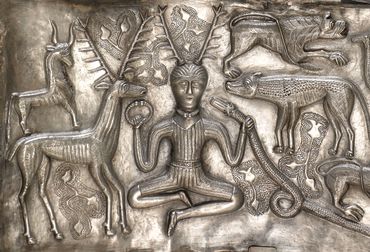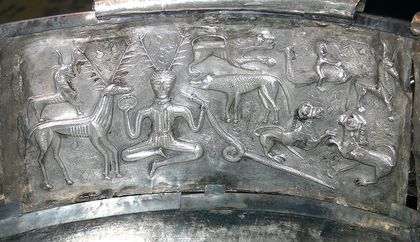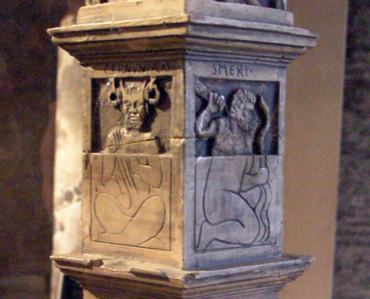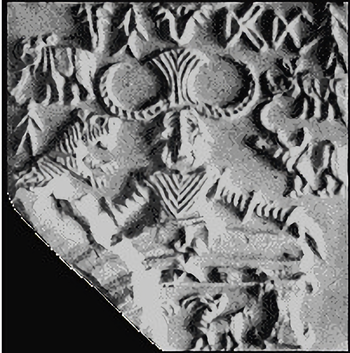「ケルヌンノス」の版間の差分
| (同じ利用者による、間の77版が非表示) | |||
| 1行目: | 1行目: | ||
| − | [[File:Gundestrupkedlen- 00054 (cropped).jpeg|thumb|right|370px| | + | [[File:Gundestrupkedlen- 00054 (cropped).jpeg|thumb|right|370px|コペンハーゲンのデンマーク国立博物館に展示されているグンデストルップの大釜(Gundestrup Cauldron)のケルヌンノス型角神像。]] |
| + | [[File:Gundestrupkarret2.jpeg|thumb|right|420px|コペンハーゲンのデンマーク国立博物館に展示されているグンデストルップの大釜(Gundestrup Cauldron)のケルヌンノス型角神像。]] | ||
<sup>''(参照方法、2021年8月)''</sup> | <sup>''(参照方法、2021年8月)''</sup> | ||
'''ケルヌンノス'''(Cernunnos または Kernunnos)は、ケルト神話の狩猟の神にして冥府神。獣王・動物王であったと推定されている。また、多産と豊作に関係があったと考えられている。古代ケルトやガロ・ローマの宗教では、ケルヌンノス(Cernunnos)またはカルノノス(Carnonos)は角を持ち、あぐらをかいて座る姿で描かれた神で、鹿、角のある大蛇、犬、雄牛と関連している。ケルヌンノスは通常、トルクを持つか身につけており、時にはコイン(または穀物)の入った袋とコルヌコピアを持つ姿も見られる<ref>Green, Miranda, ''Celtic Art, Reading the Messages'', p. 147, 1996, The Everyman Art Library, ISBN:0-297-83365-0</ref>。ケルヌンノスは、元々はケルトの神であったと考えられており、ガリア北東部を中心に50以上の描写や碑文が残されている。 | '''ケルヌンノス'''(Cernunnos または Kernunnos)は、ケルト神話の狩猟の神にして冥府神。獣王・動物王であったと推定されている。また、多産と豊作に関係があったと考えられている。古代ケルトやガロ・ローマの宗教では、ケルヌンノス(Cernunnos)またはカルノノス(Carnonos)は角を持ち、あぐらをかいて座る姿で描かれた神で、鹿、角のある大蛇、犬、雄牛と関連している。ケルヌンノスは通常、トルクを持つか身につけており、時にはコイン(または穀物)の入った袋とコルヌコピアを持つ姿も見られる<ref>Green, Miranda, ''Celtic Art, Reading the Messages'', p. 147, 1996, The Everyman Art Library, ISBN:0-297-83365-0</ref>。ケルヌンノスは、元々はケルトの神であったと考えられており、ガリア北東部を中心に50以上の描写や碑文が残されている。 | ||
| − | == | + | == 概要 == |
| − | + | ケルヌンノスという名称はパリで出土した「船乗りの柱」に見られる(ただし不完全で、冒頭の1文字が欠けている)。彼の姿は、デンマークで発見され、紀元前1世紀まで遡るとされる銀製の[[グンデストルップの大釜]](Gundestrup Cauldron)にも描かれている。ここでは、彼は胡坐をかいており、頭に二本の角、手には[[ヤギ|山羊]](もしくは[[ヒツジ|雄羊]])頭の[[ヘビ|蛇]]を持っている。これは角のある神としての一般的な描写である。<sup>''要出典範囲、地母神を妻としたが、この女神は後に破壊神エススについた、2015年10月</sup>。 | |
| − | |||
| − | + | == 起源 == | |
| + | 碑文や絵画、像といった考古学的資料によると、ケルヌンノスはガリア、北イタリア(Gallia Cisalpina)、ブリテンの南の沿岸地方で崇拝されていた。イタリアのヴァル・カモニカ(Val Camonica)で発見されたものが最古の描写と思われ、これは紀元前4世紀のものである。もっとも有名なものはデンマークで見つかったグンデストルップの大釜(Gundestrup Cauldron)で、これは紀元前1世紀のものである。この神の名前はパリの「船乗りの柱」から知られる。この奉献碑は現在パリの国立中世美術館に展示されている。ガリア人の水夫達が1世紀の初めに作ったもので、碑文(CIL XIII number 03026)からみておそらく紀元14年、ティベリウス皇帝の即位の際のものであろう。これが発見されたのは1710年のことで、ノートルダム寺院の基礎からであった。この場所はルテティア(パリの古代ローマ時代の名前)、ケルトのパリシイ族の「市民的な」(civitas)首都であった。そこにはケルヌンノス初め各種ケルトの神々が[[ユーピテル]]、[[ウゥルカーヌス]]、[[カストール|カストル]]、[[ポリュデウケース|ポルックス]]といったローマ神話の神々と並んで描かれている。 | ||
| − | " | + | この神の名前を書いた出土品としては「船乗りの柱」が最も古いものだが、他にも二つの同様な碑文が見つかっている。一つは Treveri の勢力圏であった Seinsel-Rëlent (ルクセンブルク)で発見された金属の飾り板である。この碑文からは "Deo Ceruninco" (神ケルニンコスに)という文字が読み取れる(AE 1987, 0772)。もう一つは フランスのラングドック=ルシヨン地域圏エロー県にあるモンタニャック(Montagnac)で発見されたゴール(Gaul)の碑文で、ギリシア語で "αλλετ[ει]υος καρνονου αλ[ι]σο[ντ]εας" とカルノノスの名が記されている。 |
| − | == | + | == 名前と語源 == |
| − | + | 「船乗りの柱」の碑文は [_]ernunnos となっており、いつかの時点で名前の最初の文字が欠落している。しかし、この名前を "Cernunnos" と復元するのに問題点はない。というのは、名前の下に枝角を持った神の絵があるからで、ガリア語の carnon, cernon は「枝角」、「角」を意味している(Delmarre, 1987 pp. 106 - 107)。同様に、古いアイルランド語では cern は「角」、 "bumb, boss" を意味し、ウェールズ語やブレトン語の類似単語 carn とも語源的に関連している。これらは原インド・ヨーロッパ語の *krno- からきたものである。ラテン語の cornu 、ゲルマン語の *hurnaz (英語の "horn" の元)も同じ語源である(Nussbaum 1986; Porkorny 1959 pp.574 - 576)。 Carnutes、Carni、Carnonacae といった部族名、進軍ラッパの carnyx にも同一のガリア語の語源が見いだされる。そこでこの神名素の原ケルト語形は *Kerno-on-os ないし *Karno-on-os と再構成できる。どちらも「角のある男性的な(霊)」という意味である。 -on- という部分は非常に多いわけではないがしばしば神名素に現れる。例えば、マポノス(Map-on-os)、[[エポナ]](Ep-on-a)、マトロナエ(Matr-on-a)、シローナ(Sir-on-a)のように。 | |
| − | + | 受け入れられているケルト語の音韻規則に従えば、この原ケルト神名素の Romano-British 形は *Cernonos か *Carnonos であったと思われる。いずれもガリ語の Cernunnos と極めて似ている(以上、日本語版Wikipedia)。 | |
| − | |||
| − | |||
| − | + | ガリア語では、Cernunnosの名前の語源は、「角」「鹿の角」を意味するkarnonである。 Karnonはラテン語の''cornu''やゲルマン語の''*hurnaz''と同族で、最終的にはプロト・インド・ヨーロッパ語の''*k̑r̥no-''に由来する<ref>Pokorny (1959) "k̑er-, k̑erə-; k̑rā-, k̑erei-, k̑ereu"[http://www.utexas.edu/cola/centers/lrc/ielex/X/P0929.html], https://web.archive.org/web/20140307155522/http://www.utexas.edu/cola/centers/lrc/ielex/X/P0929.html, 2014-03-07 </ref>。大陸ケルト語のガリア人とガラテヤ人の支流には、「角」(''karn-'' "horn")という語源が見られる。アレキサンドリアのヘシキウス(Hesychius)は、ガラテヤ語のkarnon (κάρνον) を「ガリアのラッパ」、つまりテサロニカのエウスタティウス(Eustathius)がcarnix (κάρνυξ) として挙げたケルト軍の角笛を、動物の形の鐘を持つ楽器と解釈している<ref>Delamarre; Greek text and English translation of the passage from Eustathius' Homeric commentaries given by Edward Wigan, "Account of a Collection of Roman Gold Coins", ''Numismatic Chronicle'' 5 (1865), p. 11 [https://books.google.com/books?id=0VwUAAAAYAAJ&pg=PA11&dq=carnyx+Eustathius&hl=en&ei=yEPDTMPmA4SfnAf__a3UCQ&sa=X&oi=book_result&ct=result&resnum=2&ved=0CCsQ6AEwAQ#v=onepage&q=carnyx%20Eustathius&f=false online.]</ref>。この語源はケルトの諸集団の名前にも現れ、中でも「角のある者」という意味のCarnutesが有名である<ref>Also ''Carni'' and ''Carnonacae''.</ref>。また、碑文に見られるいくつかの人名にも見られる<ref>Such as ''Carnarus'', ''Carnatus'', ''Carneolus'', ''Carnius'', and ''Carnicus''. Altay Coşkun and Jürgen Zeidler, "'Cover Names' and Nomenclature in Late Roman Gaul: The Evidence of the Bordelaise Poet Ausonius" (2003), p. 33.</ref>。 | |
| − | == | + | プロト・ケルト語のテオニムの形態は、*''Carno-on-os''として再構築されている。マポノス、エポナ、マトロエナ、シローナなどのように、増大詞の-on-はテオニムの特徴である<ref>Delamarre, citing M. Lejeune, ''Lepontica'' (Paris 1971), p. 325.</ref>。マイヤー(Maier(2010))は、Cernunnosの語源は不明だが、ケルト語の「角」または「鹿の角」(Carnonosと同様)に根ざしていると思われると述べている<ref name="Maier">Bernard Maier, [https://books.google.com/books?id=7AvdTqwucfwC&pg=PA69&dq=%22the+etymology+of+whose+name+is+unclear%22&hl=en&ei=2E3ETPjlFcWOnwfrmpHZCQ&sa=X&oi=book_result&ct=result&resnum=1&ved=0CC0Q6AEwAA#v=onepage&q=%22the%20etymology%20of%20whose%20name%20is%20unclear%22&f=false ''Dictionary of Celtic Religion and Culture''] (Alfred Kröner, 1994; Boydell, 2000), p. 69.</ref>。 |
| − | |||
| − | + | 「ケルヌンノス」は、ケルト人によっては、ガリア神話の中でもっとよく知られた神の不明瞭な蔑称であると信じている。おそらく『ローマ語訳(Interpretatio Romana)』にメルクリウスまたはディス・パテルとして記述されている神で<ref name="Anne Ross 1967"/>、ケルヌンノスの精神文化または神々の関連性を共有していると考えられていた<ref name=Breviary2005>Celtic Culture: A Historical Encyclopedia, Breviary A., Kock John T., ABC-CLIO, volume1, 2005, Celticism, pages396, isbn:978-1851094400, id:f899xH_quaMC, page=396</ref>。この名前は一度だけ図像付きで登場し、「船乗りの柱(ガリア人の一族であるパリシイ族の船員による))」に刻まれた。その他、エロー県モンタニャックのギリシャ文字で書かれたケルト語の碑文にも、ケルヌンノスの名前のバリエーションが見られる(καρνονου, karnonou, in dative case)<ref>Xavier Delamarre, ''Dictionnaire de la langue gauloise'' (Éditions Errance, 2003), pp. 106–107.</ref>。ガロ・ラテン語の形容詞carnuātus「角のある」も発見されている<ref>Equivalent to Latin ''cornutus'', "horned"; Delamarre, citing J. Vendryes, ''Revue Celtique'' 42 (1925) 221–222.</ref>。 | |
| − | + | == 碑文学的証拠 == | |
| + | ケルヌンノスに関する神話や、彼が持っていたと思われる様々な蔑称の物語、宗教的実践や信者に関する情報など、ガリア文学が現存していないため、ガリアの宗教的伝統における彼の全体的な意義は不明である。ガリア文化における彼の役割の解釈は、動物、自然、豊穣の神と見なすものから、旅行、商業、双方向性の神と見なすものまで様々である<ref>Green Miranda, Animals in Celtic Life and Myth, pages227–8, 1992, Routledge, https://ceisiwrserith.com/therest/Cernunnos/cernunnospaper.htm</ref>ケルヌンノスの存在の証拠に、さまざまな遺物に刻まれた碑文が残っているのみである。 | ||
| − | + | 「船乗りの柱」はは、おそらく紀元14年にガリア人の船乗りたちによって建てられたものである<ref>Based on the inscription (''CIL'' XIII. 03026), on the accession of the Roman emperors|emperor Tiberius.</ref>。1710年、ケルト系パリ人の首都であった古代ルテティアの遺跡であるパリのノートルダム大聖堂の基礎の中から発見されたものである。現在、パリの国立モヤーン時代美術館に展示されている<ref name="A. Kingsley Porter 1934 p. 227">A. Kingsley Porter, "A Sculpture at Tandragee," ''Burlington Magazine'' 65 (1934), p. 227, pointing out the relative maturation of the antlers.</ref>。この特徴的な石柱は、ガロ・ローマ時代の宗教の重要な遺跡である。 その低いレリーフには、ユーピテル、ウゥルカーヌス、カストールとポルックスといったローマの神々や、[[エスス]]、スメルトリオス、タルボス・トリガラヌスといったガリアの神々が描かれ、名前が記されている。ケルヌンノス(''Cernunnos'')という名前は、18世紀の碑文の図面からはっきりと読み取ることができるが、その後、頭文字が不明瞭になり、現在では「[_]ernunnos」という読み方しか確認することができない<ref>Phyllis Fray Bober, ''Cernunnos: Origin and Transformation of a Celtic Divinity'', American Journal of Archaeology, Vol. 55, No. 1 (Jan., 1951), pp. 13-51, https://www.jstor.org/stable/501179</ref>。 | |
| − | + | さらに、ケルトのトレヴェリ族の領土であるルクセンブルクのシュタインセル・ルーレントの金属板に刻まれた1つの銘文が、ケルヌンノスの存在の根拠となっている。 この碑文<ref>AE 1987, 0772 = AE 1989, 00542.</ref>には「セルニンコス神に(''Deo Ceruninco'')」とあり、同じ神であると推測される<sup>''(要出典, October 2010)''</sup>。 モンタニャックのガリア語碑文[17]には、「αλλετ[ει]νος καρνονου αλ[ι]σο[ντ]εας (アルレテxノス(Alletinos) [これを捧ぐ] アリソンテア(Alisontea)のカルノノス(Carnonos)) とあり、最後の言葉はおそらく Alisia 「奉仕の木」あるいは「岩」(Alesia、ガリアのAlisiiaと比較)に基づく地名であるだろうと考えられている<ref>Delamarre, ''Dictionnaire'' pp. 38–39. See also Pierre-Yves Lambert, ''La langue gauloise'' (Éditions Errance, 2003), pp. 53 and 58.</ref>。ケルヌンノスは決してローマに同化されなかったが、学者たちは彼をマーキュリー、アクタイオン、ユーピテルの特殊な形態、ディス・パテル(後者はユリウス・カエサルがガリア人の祖先と見なすと述べた)などギリシャ・ローマの神と機能的に比較することがあった[29]。 | |
| − | + | == 図像 == | |
| + | [[File:Boatp.png|thumb|right|370px|パリの「船乗りの柱」のケルヌンノス (国立中世美術館所蔵)。]] | ||
| + | [[ファイル:Image-Pashupati3.png| 350px |thumb|'''<参考>'''モヘンジョダロで出土した封印 - [[パシュパティ]](獣の王)<ref group="私注">冠が「オメガ」の形のように思える。</ref>]] | ||
| + | ケルヌンノスの描かれ方はケルト圏を通じ極めて一貫している。もっともわかりやすい特徴は牡鹿の角であり、通常長髪で髭をたくわえた成人男性の姿で、ケルトで高貴のしるしである豪華な装飾を施された首輪、トルクを身に付けている。硬貨で一杯の財布を持つのと同様に、しばしば他のトルクを腕や角にぶら下げているものもある。通常、足を組んで座る姿で描かれ、その姿勢は瞑想しているともシャーマンの呪術を行なう姿ともいわれているが、実際はケルト人が狩猟のときにしゃがむという事実を反映しているに過ぎないのかもしれない。 | ||
| − | + | ケルヌンノスはほとんど常に動物、特に牡鹿と共に描かれる。しばしばこの神特有の動物であり第一の眷属と考えられる牡羊の角をもった'''蛇'''と共に描かれるが、蛇自体も神であったかもしれない。また、これらほど頻繁ではないものの[[ウシ|牡牛]]<sup>1</sup>、[[イヌ|犬]]や[[ラット|ドブネズミ]]などの獣が傍らに描かれることもある。動物と共に描かれることが多いことから、研究者はケルヌンノスを「百獣の神」ないし「野生の神」と呼ぶことがある。特に牡鹿と共に描かれ、これが主要な獲物であったことから「狩猟の神」と呼ばれることもある。興味深いことに「船乗りの柱」はケルヌンノスを水夫や貿易と結びつけるが、古代にはドゥロコルトルムというレミ族の城市だったフランス、シャンパーニュ地方のマルヌ県から出土したケルヌンノスの硬貨入れや、トレウェリ族の居住地内にあったルクセンブルクの Niedercorn-Turbelslach から出土した硬貨を吐き出す鹿などから彼と物質的な豊かさとの関連が伺える。また、この神は森に住む鹿の繁殖力の象徴であったかもしれない。 | |
| − | |||
| − | |||
| − | + | 「船乗りの柱」には、鹿の角を持つ像が描かれており、二つの角にはトルクがぶら下がっていて、''ケルヌンノス''([C]ernunnos)の銘が一緒に刻まれている。 レリーフの下部は欠けているが、その寸法から、神は伝統的に「仏陀の姿勢(Buddhic posture)」と呼ばれる描写で、あぐらをかいて座っていたと考えられ<ref>Blázquez Martínez, J. M. (1957). ''Una réplica desconocida al Cernunnos de Val Camonica: el Cernunnos de Numancia''. Revue d'Études Ligures, 23, fasc. 3-4, 1957, pp. 294-298.</ref>、グンデストルップの大釜の角のある像と直接的に類似したものとなっている<ref>https://books.google.com/books?id=m8-IAgAAQBAJ&q=Iconography+of+cernunnos+Gundestrup+cauldron&pg=PA89, Symbol and Image in Celtic Religious Art, Green Miranda, 2003-10-03, Routledge, isbn:9781134893942</ref>。 | |
| − | |||
| − | + | ケルヌンノスに関連する図像には、牡鹿と雄羊の角を持つ蛇が描かれていることが多い。あまり多くはないが、牡牛(ランス)、犬、ネズミもいる<ref>https://books.google.com/books?id=VZkTDQAAQBAJ&q=Iconography+of+cernunnos&pg=PT148, Gods of the Celts, Green Miranda, 2011-09-30, The History Press, isbn:9780752468112</ref>。グンデストルップの大釜に描かれた彼の像から、ケルヌンノスを「動物の神」または「野生物の神」と表現する学者もおり、ミランダ・グリーンは彼を「自然と実りの平和な神」<ref>Green, Miranda (1992) ''Animals in Celtic Life and Myth'', p. 228.</ref>と表現し、しばしば動物に囲まれて描かれる伝統的なシャーマンを思わせる形で座っているようだと述べている<ref>Caesar's Druids: story of an ancient priesthood, Aldhouse-Green, Miranda J., Yale University Press, 2010, isbn:9780300165883, location:New Haven, pages86, oclc:808346501</ref><ref group="私注">好戦的な古代のガリア人は「平和の神」など尊ばなかったのではないだろうか。</ref>。 また、チェイサ-・セリス(Ceisiwr Serith)は、ケルヌンノスを双方向性の神、対立するものの間を取り持つ神としており、作品中の動物の象徴はこの考えを反映していると見ている<ref>Fickett-Wilbar, David, 2003, Cernunnos: Looking a Different Way, Proceedings of the Harvard Celtic Colloquium, volume23, pages80–111, issn:1545-0155, jstor:25660728</ref>。 | |
| − | + | 「船乗りの柱」は彼を船員や商業と結びつけており、ランス(フランス、シャンパーニュ地方マルヌ県)のケルヌンノス(古代、レミ族の都市ドロコルトウム(Durocortorum))の硬貨入れやトレヴェリ族の土地ニーデルコルン-トルベルスラッフ(Niedercorn-Turbelslach(ルクセンブルグ))の鹿が吐く硬貨と同様に、彼も物質的豊かさと関連していたことが示唆される。ケルヌンノスは、鹿の生息する森の豊穣を象徴していたのかもしれない。 | |
| − | == | + | ケルヌンノス像の他の例としては、ガリア・キサルピナ(Cisalpine Gaul)のヴァルカモニカの岩絵群(Val Camonica)にあるペトログリフがある<ref name=Breviary2005/><ref name=Webster/>。角のある人物の像は、早ければ紀元前7世紀、遅くとも紀元前4世紀とされている<ref name=Webster>Webster, "Creolizing the Roman Provinces," p. 221, especially note 103.</ref>。フランスのブザンソン(Besançon)とクレルモンフェラン(Clermont-Ferrand)に角の生えた2体の女神が登場する。古代ローマ時代のサイレンセスター(Cirencester)のレリーフや、ハンプシャー州ピータースフィールド(Petersfield)のコインに描かれた鹿の角のある神が認められる<ref name=Breviary2005/>。ヴァンドゥーブル(Vendeuvres)のレリーフには、角の生えた子供が蛇に挟まれ、財布とトルクを手にして描かれている<ref>Anne Ross, "Chain Symbolism in Pagan Celtic Religion," ''Speculum'' 34 (1959), p. 42.</ref>。最もよく知られているのは、ユトランド半島で発見された紀元前1世紀のグンデストルップの大釜で、ケルトの題材が描かれていると考えられているが、通常はトラキア人の作と考えられている。 |
| − | |||
| − | |||
| − | + | ケルティベリア人の中では、ケルヌンノス型の角や角を持った像として、カンデラリオ(Candelario) (サラマンカ(Salamanca)) から出土した二つの顔と二つの小さな角を持つ「ヤヌスのような(Janus-like)」神、リオティント(Ríotinto) (ウエルバ(Huelva)) の丘から出土した角を持った神、ロ-リザン(Lourizán)(ポンテベドラ(Pontevedra)) の祭壇近くにいたヴェスティウス・アロニエカス(Vestius Aloniecus)神の表現と思われるものなどがある。角は「攻撃的な力、遺伝的な活力、繁殖力」を表すとされる<ref>Francisco Marco Simón, "Religion and Religious Practices of the Ancient Celts of the Iberian Peninsula," ''e-Keltoi: Journal of Interdisciplinary Celtic Studies'' 6 (2005), p. 310.</ref>。 | |
| − | + | ケルト人が人間の姿をした神々を描くようになったのは、ローマ帝国のガリア征服以後のことだという説があるが、ケルヌンノス型の神像はその例外である<ref>Webster, "Creolizing the Roman Provinces," p. 221.</ref>。ケルトの「角のある神」は、図像ではよく知られているが、ローマ民俗誌のケルト宗教の記述では確認できず、ローマ時代のパンテオンに翻訳するには特徴が強すぎたためか、いかなる解釈も与えられていないようである<ref>Jane Webster, "Creolizing the Roman Provinces," ''American Journal of Archaeology'' 105 (2001), p. 222; distinctiveness of Cernunnos also in William Van Andringa, "Religions and the Integration of Cities in the Empire in the Second Century AD: The Creation of a Common Religious Language," in ''A Companion to Roman Religion'' (Blackwell, 2007), pp. 87–88.</ref>。ケルヌンノスは決してローマに同化されなかったが、学者たちは彼をマーキュリー、アクタイオン<ref>David M. Robinson and Elizabeth Pierce Belgen, "Archaeological Notes and Discussions," ''American Journal of Archaeology'' 41 (1937), p. 132.</ref>、ユーピテルの特殊な形態、ディス・パテル(後者はユリウス・カエサルがガリア人の祖先と見なすと述べた)などギリシャ・ローマの神格と機能的に比較することがあった<ref>Phyllis Fray Bober, "Cernunnos: Origin and Transformation of a Celtic Divinity," ''American Journal of Archaeology'' 55 (1951), p. 15ff.</ref>。 | |
| − | |||
| − | + | == 島のケルトの投影の可能性 == | |
| + | アルスター物語群に登場するアイルランドの英雄クー・フーリン<ref>Porter, ''A Sculpture at Tandragee'', p. 227.</ref>の育ての親であるコナール・サーナッハ(Conall Cernach)の名前にcernの語源を見出そうとする試みがなされている。この解釈では、セルナッハ(Cernachは)「角ばった、勝利した、突出した」という広い意味を持つ蔑称とされるが、コナールとケルヌンノスが関連しているという証拠はほとんどない<ref>John Koch. (2006) Cernunnos [in] ''Celtic Culture: A Historical Encyclopedia'', p. 396. ABC-Clio.</ref>。 | ||
| − | = | + | 8世紀に書かれた「Táin Bó Fraích」(「Fraechへの牛の襲撃」)という物語に登場するコナールの短い一節は、コナールが「獣の主人」としての属性を備えていたことの証拠とされている<ref name="Anne Ross 1967">Anne Ross. (1967, 1996). ''Pagan Celtic Britain: Studies in Iconography and Tradition''. Academy Chicago Publishers.</ref>。この物語では、コナール・サーナハは、主人公フリーチが妻と息子を救出し、家畜を取り戻すのを助ける英雄であり、強大な戦士として描かれている。コナールが侵入しなければならない砦は、大蛇が守っていた。この物語の最大の山場は、恐ろしい大蛇がコナールを襲う代わりに、コナールの腰に飛び込んできて、ベルトのようにコナールを包むところである。コナールは大蛇を殺さず、生かしておいて、大蛇が守っていた砦の財宝を奪っていく<ref group="私注">コナールと大蛇が一体化していることが示されているように思う。</ref>。コナール・サーナッハの姿は、他の場所では動物や林業と関連付けられておらず、"Cernach "という蔑称は、コナールが怪我から身を守るために "角のように"皮膚を突き通せないようにしたという説明で伝統的に説明されている。 |
| − | |||
| − | |||
| − | |||
| − | == | + | == 聖キアランとの関連の可能性 == |
| − | + | ケルヌンノスの特質は、アイルランド十二使徒の一人である聖キアラン・オブ・サイギールの生涯に内包されているとする説もある。彼の伝記によると、最初の小さな独房を建てるとき、彼の最初の弟子であり修道士は、神によって祝福されたイノシシであったという。この後、狐、狢、狼、牡鹿と続いた<ref>Mac Cana Proinsias, Celtic Mythology, 1970, 1973, The Hamlyn Publishing Group Limited, London, isbn:0-600-00647-6, [https://archive.org/details/celticmythology00macc/page/47 47–8], registration, https://archive.org/details/celticmythology00macc/page/47</ref>。 | |
| − | |||
| − | |||
| − | |||
| − | |||
| − | |||
| − | |||
| − | |||
| − | |||
| − | |||
| − | |||
| − | |||
| − | |||
| − | |||
| − | |||
| − | |||
| − | |||
| − | |||
| − | |||
| − | |||
| − | |||
| − | |||
| − | |||
| − | |||
| − | |||
| − | |||
| − | |||
| − | |||
| − | |||
| − | |||
| − | |||
| − | |||
| − | |||
| − | |||
| − | |||
| − | |||
| − | |||
| − | |||
| − | |||
== 中世の痕跡 == | == 中世の痕跡 == | ||
| 111行目: | 67行目: | ||
== 参考文献 == | == 参考文献 == | ||
* Wikipedia:[https://ja.wikipedia.org/wiki/%E3%82%B1%E3%83%AB%E3%83%8C%E3%83%B3%E3%83%8E%E3%82%B9 ケルヌンノス](最終閲覧日:22-11-12) | * Wikipedia:[https://ja.wikipedia.org/wiki/%E3%82%B1%E3%83%AB%E3%83%8C%E3%83%B3%E3%83%8E%E3%82%B9 ケルヌンノス](最終閲覧日:22-11-12) | ||
| + | * Wikipedia:[https://en.wikipedia.org/wiki/Cernunnos Cernunnos](最終閲覧日:22-11-21) | ||
** ''Corpus Inscriptionum Latinarum'' (CIL) volume 13, number 03026 | ** ''Corpus Inscriptionum Latinarum'' (CIL) volume 13, number 03026 | ||
** Delmarre, Xavier (2003) ''Dictionnarie de la langue gauloise'' (2nd ed.) Paris: Editions Errance. ISBN 2-87772-237-6 | ** Delmarre, Xavier (2003) ''Dictionnarie de la langue gauloise'' (2nd ed.) Paris: Editions Errance. ISBN 2-87772-237-6 | ||
| 116行目: | 73行目: | ||
** Nussbaum, Alan J. (1986) ''Head and Horn in Indo-European'', Berlin, New York: Walter de Gruyter. ISBN 3110104490 | ** Nussbaum, Alan J. (1986) ''Head and Horn in Indo-European'', Berlin, New York: Walter de Gruyter. ISBN 3110104490 | ||
** Porkorny, Julius (1959) ''Indogermanisches etymologisches Wörterbuch'' Berlin: Franke Verlag | ** Porkorny, Julius (1959) ''Indogermanisches etymologisches Wörterbuch'' Berlin: Franke Verlag | ||
| + | * Wikipedia:[https://fr.wikipedia.org/wiki/Chaudron_de_Gundestrup Chaudron de Gundestrup](フランス語版)(最終閲覧日:22-11-18) | ||
== 関連項目 == | == 関連項目 == | ||
| − | |||
* [[ヴェレス]], [[ペルーン]] | * [[ヴェレス]], [[ペルーン]] | ||
| + | * [[Abbots Bromley Horn Dance]] | ||
| + | * [[Green Man]] | ||
| + | * [[Herne the Hunter]] | ||
| + | * [[Horned God]] | ||
== 外部リンク == | == 外部リンク == | ||
* [http://www.shadowdrake.com/celtic/gundestrup.html Gundestrup Cauldron(英語サイト)] | * [http://www.shadowdrake.com/celtic/gundestrup.html Gundestrup Cauldron(英語サイト)] | ||
| + | * [http://www.shadowdrake.com/celtic/gundestrup.html "Is the Gundestrup Cauldron an Authentic Celtic Artifact?"]: A possibly ancient depiction of the Horned God | ||
| + | |||
| + | == 私的注釈 == | ||
| + | <references group="私注"/> | ||
| + | |||
| + | == 参照 == | ||
| + | <references /> | ||
{{DEFAULTSORT:けるぬんのす}} | {{DEFAULTSORT:けるぬんのす}} | ||
| 138行目: | 106行目: | ||
[[Category:鼠]] | [[Category:鼠]] | ||
[[Category:炎帝型神]] | [[Category:炎帝型神]] | ||
| + | [[Category:グンデストルップの大釜]] | ||
| + | [[Category:船乗りの柱]] | ||
| + | [[Category:アルパとオメガ]] | ||
2022年12月15日 (木) 05:46時点における最新版
(参照方法、2021年8月) ケルヌンノス(Cernunnos または Kernunnos)は、ケルト神話の狩猟の神にして冥府神。獣王・動物王であったと推定されている。また、多産と豊作に関係があったと考えられている。古代ケルトやガロ・ローマの宗教では、ケルヌンノス(Cernunnos)またはカルノノス(Carnonos)は角を持ち、あぐらをかいて座る姿で描かれた神で、鹿、角のある大蛇、犬、雄牛と関連している。ケルヌンノスは通常、トルクを持つか身につけており、時にはコイン(または穀物)の入った袋とコルヌコピアを持つ姿も見られる[1]。ケルヌンノスは、元々はケルトの神であったと考えられており、ガリア北東部を中心に50以上の描写や碑文が残されている。
目次
概要[編集]
ケルヌンノスという名称はパリで出土した「船乗りの柱」に見られる(ただし不完全で、冒頭の1文字が欠けている)。彼の姿は、デンマークで発見され、紀元前1世紀まで遡るとされる銀製のグンデストルップの大釜(Gundestrup Cauldron)にも描かれている。ここでは、彼は胡坐をかいており、頭に二本の角、手には山羊(もしくは雄羊)頭の蛇を持っている。これは角のある神としての一般的な描写である。要出典範囲、地母神を妻としたが、この女神は後に破壊神エススについた、2015年10月。
起源[編集]
碑文や絵画、像といった考古学的資料によると、ケルヌンノスはガリア、北イタリア(Gallia Cisalpina)、ブリテンの南の沿岸地方で崇拝されていた。イタリアのヴァル・カモニカ(Val Camonica)で発見されたものが最古の描写と思われ、これは紀元前4世紀のものである。もっとも有名なものはデンマークで見つかったグンデストルップの大釜(Gundestrup Cauldron)で、これは紀元前1世紀のものである。この神の名前はパリの「船乗りの柱」から知られる。この奉献碑は現在パリの国立中世美術館に展示されている。ガリア人の水夫達が1世紀の初めに作ったもので、碑文(CIL XIII number 03026)からみておそらく紀元14年、ティベリウス皇帝の即位の際のものであろう。これが発見されたのは1710年のことで、ノートルダム寺院の基礎からであった。この場所はルテティア(パリの古代ローマ時代の名前)、ケルトのパリシイ族の「市民的な」(civitas)首都であった。そこにはケルヌンノス初め各種ケルトの神々がユーピテル、ウゥルカーヌス、カストル、ポルックスといったローマ神話の神々と並んで描かれている。
この神の名前を書いた出土品としては「船乗りの柱」が最も古いものだが、他にも二つの同様な碑文が見つかっている。一つは Treveri の勢力圏であった Seinsel-Rëlent (ルクセンブルク)で発見された金属の飾り板である。この碑文からは "Deo Ceruninco" (神ケルニンコスに)という文字が読み取れる(AE 1987, 0772)。もう一つは フランスのラングドック=ルシヨン地域圏エロー県にあるモンタニャック(Montagnac)で発見されたゴール(Gaul)の碑文で、ギリシア語で "αλλετ[ει]υος καρνονου αλ[ι]σο[ντ]εας" とカルノノスの名が記されている。
名前と語源[編集]
「船乗りの柱」の碑文は [_]ernunnos となっており、いつかの時点で名前の最初の文字が欠落している。しかし、この名前を "Cernunnos" と復元するのに問題点はない。というのは、名前の下に枝角を持った神の絵があるからで、ガリア語の carnon, cernon は「枝角」、「角」を意味している(Delmarre, 1987 pp. 106 - 107)。同様に、古いアイルランド語では cern は「角」、 "bumb, boss" を意味し、ウェールズ語やブレトン語の類似単語 carn とも語源的に関連している。これらは原インド・ヨーロッパ語の *krno- からきたものである。ラテン語の cornu 、ゲルマン語の *hurnaz (英語の "horn" の元)も同じ語源である(Nussbaum 1986; Porkorny 1959 pp.574 - 576)。 Carnutes、Carni、Carnonacae といった部族名、進軍ラッパの carnyx にも同一のガリア語の語源が見いだされる。そこでこの神名素の原ケルト語形は *Kerno-on-os ないし *Karno-on-os と再構成できる。どちらも「角のある男性的な(霊)」という意味である。 -on- という部分は非常に多いわけではないがしばしば神名素に現れる。例えば、マポノス(Map-on-os)、エポナ(Ep-on-a)、マトロナエ(Matr-on-a)、シローナ(Sir-on-a)のように。
受け入れられているケルト語の音韻規則に従えば、この原ケルト神名素の Romano-British 形は *Cernonos か *Carnonos であったと思われる。いずれもガリ語の Cernunnos と極めて似ている(以上、日本語版Wikipedia)。
ガリア語では、Cernunnosの名前の語源は、「角」「鹿の角」を意味するkarnonである。 Karnonはラテン語のcornuやゲルマン語の*hurnazと同族で、最終的にはプロト・インド・ヨーロッパ語の*k̑r̥no-に由来する[2]。大陸ケルト語のガリア人とガラテヤ人の支流には、「角」(karn- "horn")という語源が見られる。アレキサンドリアのヘシキウス(Hesychius)は、ガラテヤ語のkarnon (κάρνον) を「ガリアのラッパ」、つまりテサロニカのエウスタティウス(Eustathius)がcarnix (κάρνυξ) として挙げたケルト軍の角笛を、動物の形の鐘を持つ楽器と解釈している[3]。この語源はケルトの諸集団の名前にも現れ、中でも「角のある者」という意味のCarnutesが有名である[4]。また、碑文に見られるいくつかの人名にも見られる[5]。
プロト・ケルト語のテオニムの形態は、*Carno-on-osとして再構築されている。マポノス、エポナ、マトロエナ、シローナなどのように、増大詞の-on-はテオニムの特徴である[6]。マイヤー(Maier(2010))は、Cernunnosの語源は不明だが、ケルト語の「角」または「鹿の角」(Carnonosと同様)に根ざしていると思われると述べている[7]。
「ケルヌンノス」は、ケルト人によっては、ガリア神話の中でもっとよく知られた神の不明瞭な蔑称であると信じている。おそらく『ローマ語訳(Interpretatio Romana)』にメルクリウスまたはディス・パテルとして記述されている神で[8]、ケルヌンノスの精神文化または神々の関連性を共有していると考えられていた[9]。この名前は一度だけ図像付きで登場し、「船乗りの柱(ガリア人の一族であるパリシイ族の船員による))」に刻まれた。その他、エロー県モンタニャックのギリシャ文字で書かれたケルト語の碑文にも、ケルヌンノスの名前のバリエーションが見られる(καρνονου, karnonou, in dative case)[10]。ガロ・ラテン語の形容詞carnuātus「角のある」も発見されている[11]。
碑文学的証拠[編集]
ケルヌンノスに関する神話や、彼が持っていたと思われる様々な蔑称の物語、宗教的実践や信者に関する情報など、ガリア文学が現存していないため、ガリアの宗教的伝統における彼の全体的な意義は不明である。ガリア文化における彼の役割の解釈は、動物、自然、豊穣の神と見なすものから、旅行、商業、双方向性の神と見なすものまで様々である[12]ケルヌンノスの存在の証拠に、さまざまな遺物に刻まれた碑文が残っているのみである。
「船乗りの柱」はは、おそらく紀元14年にガリア人の船乗りたちによって建てられたものである[13]。1710年、ケルト系パリ人の首都であった古代ルテティアの遺跡であるパリのノートルダム大聖堂の基礎の中から発見されたものである。現在、パリの国立モヤーン時代美術館に展示されている[14]。この特徴的な石柱は、ガロ・ローマ時代の宗教の重要な遺跡である。 その低いレリーフには、ユーピテル、ウゥルカーヌス、カストールとポルックスといったローマの神々や、エスス、スメルトリオス、タルボス・トリガラヌスといったガリアの神々が描かれ、名前が記されている。ケルヌンノス(Cernunnos)という名前は、18世紀の碑文の図面からはっきりと読み取ることができるが、その後、頭文字が不明瞭になり、現在では「[_]ernunnos」という読み方しか確認することができない[15]。
さらに、ケルトのトレヴェリ族の領土であるルクセンブルクのシュタインセル・ルーレントの金属板に刻まれた1つの銘文が、ケルヌンノスの存在の根拠となっている。 この碑文[16]には「セルニンコス神に(Deo Ceruninco)」とあり、同じ神であると推測される(要出典, October 2010)。 モンタニャックのガリア語碑文[17]には、「αλλετ[ει]νος καρνονου αλ[ι]σο[ντ]εας (アルレテxノス(Alletinos) [これを捧ぐ] アリソンテア(Alisontea)のカルノノス(Carnonos)) とあり、最後の言葉はおそらく Alisia 「奉仕の木」あるいは「岩」(Alesia、ガリアのAlisiiaと比較)に基づく地名であるだろうと考えられている[17]。ケルヌンノスは決してローマに同化されなかったが、学者たちは彼をマーキュリー、アクタイオン、ユーピテルの特殊な形態、ディス・パテル(後者はユリウス・カエサルがガリア人の祖先と見なすと述べた)などギリシャ・ローマの神と機能的に比較することがあった[29]。
図像[編集]
ケルヌンノスの描かれ方はケルト圏を通じ極めて一貫している。もっともわかりやすい特徴は牡鹿の角であり、通常長髪で髭をたくわえた成人男性の姿で、ケルトで高貴のしるしである豪華な装飾を施された首輪、トルクを身に付けている。硬貨で一杯の財布を持つのと同様に、しばしば他のトルクを腕や角にぶら下げているものもある。通常、足を組んで座る姿で描かれ、その姿勢は瞑想しているともシャーマンの呪術を行なう姿ともいわれているが、実際はケルト人が狩猟のときにしゃがむという事実を反映しているに過ぎないのかもしれない。
ケルヌンノスはほとんど常に動物、特に牡鹿と共に描かれる。しばしばこの神特有の動物であり第一の眷属と考えられる牡羊の角をもった蛇と共に描かれるが、蛇自体も神であったかもしれない。また、これらほど頻繁ではないものの牡牛1、犬やドブネズミなどの獣が傍らに描かれることもある。動物と共に描かれることが多いことから、研究者はケルヌンノスを「百獣の神」ないし「野生の神」と呼ぶことがある。特に牡鹿と共に描かれ、これが主要な獲物であったことから「狩猟の神」と呼ばれることもある。興味深いことに「船乗りの柱」はケルヌンノスを水夫や貿易と結びつけるが、古代にはドゥロコルトルムというレミ族の城市だったフランス、シャンパーニュ地方のマルヌ県から出土したケルヌンノスの硬貨入れや、トレウェリ族の居住地内にあったルクセンブルクの Niedercorn-Turbelslach から出土した硬貨を吐き出す鹿などから彼と物質的な豊かさとの関連が伺える。また、この神は森に住む鹿の繁殖力の象徴であったかもしれない。
「船乗りの柱」には、鹿の角を持つ像が描かれており、二つの角にはトルクがぶら下がっていて、ケルヌンノス([C]ernunnos)の銘が一緒に刻まれている。 レリーフの下部は欠けているが、その寸法から、神は伝統的に「仏陀の姿勢(Buddhic posture)」と呼ばれる描写で、あぐらをかいて座っていたと考えられ[18]、グンデストルップの大釜の角のある像と直接的に類似したものとなっている[19]。
ケルヌンノスに関連する図像には、牡鹿と雄羊の角を持つ蛇が描かれていることが多い。あまり多くはないが、牡牛(ランス)、犬、ネズミもいる[20]。グンデストルップの大釜に描かれた彼の像から、ケルヌンノスを「動物の神」または「野生物の神」と表現する学者もおり、ミランダ・グリーンは彼を「自然と実りの平和な神」[21]と表現し、しばしば動物に囲まれて描かれる伝統的なシャーマンを思わせる形で座っているようだと述べている[22][私注 2]。 また、チェイサ-・セリス(Ceisiwr Serith)は、ケルヌンノスを双方向性の神、対立するものの間を取り持つ神としており、作品中の動物の象徴はこの考えを反映していると見ている[23]。
「船乗りの柱」は彼を船員や商業と結びつけており、ランス(フランス、シャンパーニュ地方マルヌ県)のケルヌンノス(古代、レミ族の都市ドロコルトウム(Durocortorum))の硬貨入れやトレヴェリ族の土地ニーデルコルン-トルベルスラッフ(Niedercorn-Turbelslach(ルクセンブルグ))の鹿が吐く硬貨と同様に、彼も物質的豊かさと関連していたことが示唆される。ケルヌンノスは、鹿の生息する森の豊穣を象徴していたのかもしれない。
ケルヌンノス像の他の例としては、ガリア・キサルピナ(Cisalpine Gaul)のヴァルカモニカの岩絵群(Val Camonica)にあるペトログリフがある[9][24]。角のある人物の像は、早ければ紀元前7世紀、遅くとも紀元前4世紀とされている[24]。フランスのブザンソン(Besançon)とクレルモンフェラン(Clermont-Ferrand)に角の生えた2体の女神が登場する。古代ローマ時代のサイレンセスター(Cirencester)のレリーフや、ハンプシャー州ピータースフィールド(Petersfield)のコインに描かれた鹿の角のある神が認められる[9]。ヴァンドゥーブル(Vendeuvres)のレリーフには、角の生えた子供が蛇に挟まれ、財布とトルクを手にして描かれている[25]。最もよく知られているのは、ユトランド半島で発見された紀元前1世紀のグンデストルップの大釜で、ケルトの題材が描かれていると考えられているが、通常はトラキア人の作と考えられている。
ケルティベリア人の中では、ケルヌンノス型の角や角を持った像として、カンデラリオ(Candelario) (サラマンカ(Salamanca)) から出土した二つの顔と二つの小さな角を持つ「ヤヌスのような(Janus-like)」神、リオティント(Ríotinto) (ウエルバ(Huelva)) の丘から出土した角を持った神、ロ-リザン(Lourizán)(ポンテベドラ(Pontevedra)) の祭壇近くにいたヴェスティウス・アロニエカス(Vestius Aloniecus)神の表現と思われるものなどがある。角は「攻撃的な力、遺伝的な活力、繁殖力」を表すとされる[26]。
ケルト人が人間の姿をした神々を描くようになったのは、ローマ帝国のガリア征服以後のことだという説があるが、ケルヌンノス型の神像はその例外である[27]。ケルトの「角のある神」は、図像ではよく知られているが、ローマ民俗誌のケルト宗教の記述では確認できず、ローマ時代のパンテオンに翻訳するには特徴が強すぎたためか、いかなる解釈も与えられていないようである[28]。ケルヌンノスは決してローマに同化されなかったが、学者たちは彼をマーキュリー、アクタイオン[29]、ユーピテルの特殊な形態、ディス・パテル(後者はユリウス・カエサルがガリア人の祖先と見なすと述べた)などギリシャ・ローマの神格と機能的に比較することがあった[30]。
島のケルトの投影の可能性[編集]
アルスター物語群に登場するアイルランドの英雄クー・フーリン[31]の育ての親であるコナール・サーナッハ(Conall Cernach)の名前にcernの語源を見出そうとする試みがなされている。この解釈では、セルナッハ(Cernachは)「角ばった、勝利した、突出した」という広い意味を持つ蔑称とされるが、コナールとケルヌンノスが関連しているという証拠はほとんどない[32]。
8世紀に書かれた「Táin Bó Fraích」(「Fraechへの牛の襲撃」)という物語に登場するコナールの短い一節は、コナールが「獣の主人」としての属性を備えていたことの証拠とされている[8]。この物語では、コナール・サーナハは、主人公フリーチが妻と息子を救出し、家畜を取り戻すのを助ける英雄であり、強大な戦士として描かれている。コナールが侵入しなければならない砦は、大蛇が守っていた。この物語の最大の山場は、恐ろしい大蛇がコナールを襲う代わりに、コナールの腰に飛び込んできて、ベルトのようにコナールを包むところである。コナールは大蛇を殺さず、生かしておいて、大蛇が守っていた砦の財宝を奪っていく[私注 3]。コナール・サーナッハの姿は、他の場所では動物や林業と関連付けられておらず、"Cernach "という蔑称は、コナールが怪我から身を守るために "角のように"皮膚を突き通せないようにしたという説明で伝統的に説明されている。
聖キアランとの関連の可能性[編集]
ケルヌンノスの特質は、アイルランド十二使徒の一人である聖キアラン・オブ・サイギールの生涯に内包されているとする説もある。彼の伝記によると、最初の小さな独房を建てるとき、彼の最初の弟子であり修道士は、神によって祝福されたイノシシであったという。この後、狐、狢、狼、牡鹿と続いた[33]。
中世の痕跡[編集]
この神の痕跡はキリスト教時代にまでたどることができる。ウェールズとアイルランド双方の文学的伝統の中で、この神を仄めかす記述を見つけることができる。ブリタニーでは伝説の聖者、カルナック(Carnac)のコーネリ(Korneli または Cornély)にケルヌンノスの属性がある。イギリスの民間伝承にみられる狩人ハーン(Herne the Hunter)もケルヌンノスの暗示であると示唆する説もあるが、ハーンはウィリアム・シェイクスピアの劇『ウインザーの陽気な女房達』第4幕第4場で初めて言及されるサクソン人の生き残りであることから、この説は疑わしい。
復興異教主義[編集]
ウイッカに代表される現代の復興異教主義運動(Neopaganism)では、角のある神に対する崇拝が復活した。信奉者はケルヌンノス一般的に生命と豊穣と死のサイクルを追っている。この神の死は現在、通常サウィン、すなわち10月31日に行われるケルトの新年の祭の日に設定されている。
歴史的なケルヌンノスと復興異教主義のそれとの大きな違いは、後者が男根的象徴の傾向を持っていることである(ただし、この特徴はヴァル・カモニカの図像に見られる)。パンとの混淆や、 サバトの悪魔レオナール等の描写から来ているのだろう。
参考文献[編集]
- Wikipedia:ケルヌンノス(最終閲覧日:22-11-12)
- Wikipedia:Cernunnos(最終閲覧日:22-11-21)
- Corpus Inscriptionum Latinarum (CIL) volume 13, number 03026
- Delmarre, Xavier (2003) Dictionnarie de la langue gauloise (2nd ed.) Paris: Editions Errance. ISBN 2-87772-237-6
- Lejeune, Michel (1995) Receuil des Inscriptions Gauloise (RIG) volume 1, Textes gallo-grecs. Paris: Editions du CNRS
- Nussbaum, Alan J. (1986) Head and Horn in Indo-European, Berlin, New York: Walter de Gruyter. ISBN 3110104490
- Porkorny, Julius (1959) Indogermanisches etymologisches Wörterbuch Berlin: Franke Verlag
- Wikipedia:Chaudron de Gundestrup(フランス語版)(最終閲覧日:22-11-18)
関連項目[編集]
外部リンク[編集]
- Gundestrup Cauldron(英語サイト)
- "Is the Gundestrup Cauldron an Authentic Celtic Artifact?": A possibly ancient depiction of the Horned God
私的注釈[編集]
参照[編集]
- ↑ Green, Miranda, Celtic Art, Reading the Messages, p. 147, 1996, The Everyman Art Library, ISBN:0-297-83365-0
- ↑ Pokorny (1959) "k̑er-, k̑erə-; k̑rā-, k̑erei-, k̑ereu"[1], https://web.archive.org/web/20140307155522/http://www.utexas.edu/cola/centers/lrc/ielex/X/P0929.html, 2014-03-07
- ↑ Delamarre; Greek text and English translation of the passage from Eustathius' Homeric commentaries given by Edward Wigan, "Account of a Collection of Roman Gold Coins", Numismatic Chronicle 5 (1865), p. 11 online.
- ↑ Also Carni and Carnonacae.
- ↑ Such as Carnarus, Carnatus, Carneolus, Carnius, and Carnicus. Altay Coşkun and Jürgen Zeidler, "'Cover Names' and Nomenclature in Late Roman Gaul: The Evidence of the Bordelaise Poet Ausonius" (2003), p. 33.
- ↑ Delamarre, citing M. Lejeune, Lepontica (Paris 1971), p. 325.
- ↑ Bernard Maier, Dictionary of Celtic Religion and Culture (Alfred Kröner, 1994; Boydell, 2000), p. 69.
- ↑ 8.0 8.1 Anne Ross. (1967, 1996). Pagan Celtic Britain: Studies in Iconography and Tradition. Academy Chicago Publishers.
- ↑ 9.0 9.1 9.2 Celtic Culture: A Historical Encyclopedia, Breviary A., Kock John T., ABC-CLIO, volume1, 2005, Celticism, pages396, isbn:978-1851094400, id:f899xH_quaMC, page=396
- ↑ Xavier Delamarre, Dictionnaire de la langue gauloise (Éditions Errance, 2003), pp. 106–107.
- ↑ Equivalent to Latin cornutus, "horned"; Delamarre, citing J. Vendryes, Revue Celtique 42 (1925) 221–222.
- ↑ Green Miranda, Animals in Celtic Life and Myth, pages227–8, 1992, Routledge, https://ceisiwrserith.com/therest/Cernunnos/cernunnospaper.htm
- ↑ Based on the inscription (CIL XIII. 03026), on the accession of the Roman emperors|emperor Tiberius.
- ↑ A. Kingsley Porter, "A Sculpture at Tandragee," Burlington Magazine 65 (1934), p. 227, pointing out the relative maturation of the antlers.
- ↑ Phyllis Fray Bober, Cernunnos: Origin and Transformation of a Celtic Divinity, American Journal of Archaeology, Vol. 55, No. 1 (Jan., 1951), pp. 13-51, https://www.jstor.org/stable/501179
- ↑ AE 1987, 0772 = AE 1989, 00542.
- ↑ Delamarre, Dictionnaire pp. 38–39. See also Pierre-Yves Lambert, La langue gauloise (Éditions Errance, 2003), pp. 53 and 58.
- ↑ Blázquez Martínez, J. M. (1957). Una réplica desconocida al Cernunnos de Val Camonica: el Cernunnos de Numancia. Revue d'Études Ligures, 23, fasc. 3-4, 1957, pp. 294-298.
- ↑ https://books.google.com/books?id=m8-IAgAAQBAJ&q=Iconography+of+cernunnos+Gundestrup+cauldron&pg=PA89, Symbol and Image in Celtic Religious Art, Green Miranda, 2003-10-03, Routledge, isbn:9781134893942
- ↑ https://books.google.com/books?id=VZkTDQAAQBAJ&q=Iconography+of+cernunnos&pg=PT148, Gods of the Celts, Green Miranda, 2011-09-30, The History Press, isbn:9780752468112
- ↑ Green, Miranda (1992) Animals in Celtic Life and Myth, p. 228.
- ↑ Caesar's Druids: story of an ancient priesthood, Aldhouse-Green, Miranda J., Yale University Press, 2010, isbn:9780300165883, location:New Haven, pages86, oclc:808346501
- ↑ Fickett-Wilbar, David, 2003, Cernunnos: Looking a Different Way, Proceedings of the Harvard Celtic Colloquium, volume23, pages80–111, issn:1545-0155, jstor:25660728
- ↑ 24.0 24.1 Webster, "Creolizing the Roman Provinces," p. 221, especially note 103.
- ↑ Anne Ross, "Chain Symbolism in Pagan Celtic Religion," Speculum 34 (1959), p. 42.
- ↑ Francisco Marco Simón, "Religion and Religious Practices of the Ancient Celts of the Iberian Peninsula," e-Keltoi: Journal of Interdisciplinary Celtic Studies 6 (2005), p. 310.
- ↑ Webster, "Creolizing the Roman Provinces," p. 221.
- ↑ Jane Webster, "Creolizing the Roman Provinces," American Journal of Archaeology 105 (2001), p. 222; distinctiveness of Cernunnos also in William Van Andringa, "Religions and the Integration of Cities in the Empire in the Second Century AD: The Creation of a Common Religious Language," in A Companion to Roman Religion (Blackwell, 2007), pp. 87–88.
- ↑ David M. Robinson and Elizabeth Pierce Belgen, "Archaeological Notes and Discussions," American Journal of Archaeology 41 (1937), p. 132.
- ↑ Phyllis Fray Bober, "Cernunnos: Origin and Transformation of a Celtic Divinity," American Journal of Archaeology 55 (1951), p. 15ff.
- ↑ Porter, A Sculpture at Tandragee, p. 227.
- ↑ John Koch. (2006) Cernunnos [in] Celtic Culture: A Historical Encyclopedia, p. 396. ABC-Clio.
- ↑ Mac Cana Proinsias, Celtic Mythology, 1970, 1973, The Hamlyn Publishing Group Limited, London, isbn:0-600-00647-6, 47–8, registration, https://archive.org/details/celticmythology00macc/page/47



